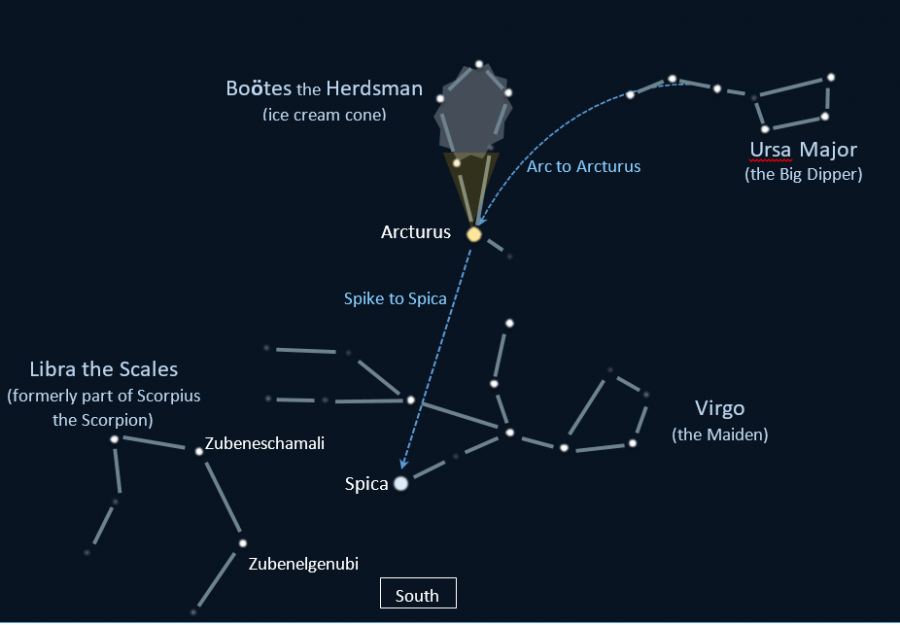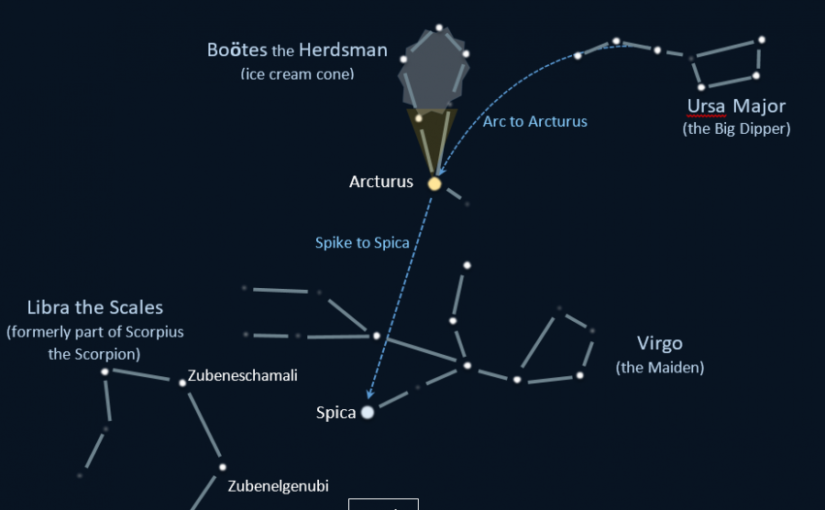In last month’s constellation post, we discussed the Bears and a Dragon.
In this month’s edition, we will talk about constellations that are ideal for warm weather observation.
“Arc to Arcturus and Spike to Spica”
If you use the drawing below to find the Big Dipper (upper right), you will see that the handle of the Dipper is curved or arced.

We can follow the arc of the Big Dipper’s handle down and to the left, towards the star Arcturus. Once there, we can “spike” down to the star Spica. Arcturus is the brightest star in Boötes the Herdsman and Spica is the brightest star in Virgo the Maiden.
Let’s talk about each one of these constellations, followed by the constellation of Libra.
Boötes the Herdsman
The original stories of this constellation originated in ancient Persia about 3,200 years ago, and were passed down to the Greeks through the Egyptians.
About 2,200 years ago, a now-famous work known as Ptolemy’s Almagest recorded 48 fairly well-known constellations. However, it was only about 1,100 years ago in which the outstanding astronomer Al Sufi, working in Persia, published a book of the known fixed stars that has become the standard for much of the scientific naming conventions since.
The stories that formed the backdrop for the constellations are often varied and even the names of the stars do not always match up perfectly to the patterns that we know today (they may have matched better in ancient times).
Boötes is an example of a constellation that has a somewhat mixed ancestry. In some cases, he is identified as Arcas, the son of Calisto (we learned about this in the April Eyes on the Skies).
In fact, the star Arcturus is often taken to mean “bear guard” or “guardian of the bear.” The name “Boötes” is thought to come from the sound that Greek herders made in rounding up their animals.
If we wanted to reinterpret these star shapes into a new constellation today, it’s easy to picture Boötes as an ice cream cone. Arcturus makes up the bottom of the cone with a star up on either side completing the pastry. The remaining stars make up the ice cream itself.
Arcturus is a beautiful reddish star that lies about 37 light years away from us. A light year is the distance light can travel in one year or just under 10 trillion kilometres. Therefore, Arcturus is 370 trillion kilometres away (and it’s one of the closer stars to us!).
Arcturus is a red giant star, a star near the end of its life that has used up most of its hydrogen. Scientists believe that our sun will become a red giant when it nears the end of its life (billions of years from now). Arcturus is about the same mass as our sun, but because red giant stars have puffier atmospheres, it is about 25 times the diameter of our star.
Virgo the Maiden
Spica is the brightest star in Virgo the Maiden. Like Boötes, there are several stories to explain Virgo.
In a story from the Classical tradition, Virgo represents Persephone, daughter of Demeter. Demeter was the fertility goddess responsible for the growth of all crops. Persephone was captured by her uncle – Hades – and forced to stay with him.
Demeter searched the earth in vain for her missing daughter. In sadness, she neglected the crops, which withered and failed. Eventually discovering the whereabouts of her daughter, she demanded Persephone’s return. Hades, however, confirmed that she could not leave as she had drunk from the underworld. By agreement between them, it was agreed that Persephone would live half the year with her mother and half the year with Hades.
During the half with her daughter, Demeter is happy and the weather is good and the crops grow. During the second half, however, Demeter misses her daughter, so the weather is poor and the crops fail.
Spica means “ear of corn” and the star represents the crops that Demeter looked over. It is eight times further away than Arcturus (nearly 250 light years). It is 10 times more massive than our sun and seven times the diameter.
Libra the Scales
The constellation of Libra represents the scales of law or justice, an interpretation that originated in ancient Greek times.
Libra was actually considered part of its neighbour to the east – Scorpius the Scorpion. As such, the stars in Libra are actually named for the “claws” of Scorpius. The northern claw is “Zubeneschamali” and the southern claw star is “Zubenelgenubi.” The middle star is “Zubenelakrab.”
For more on this month’s astronomy, visit our May Eyes on the Skies post.
